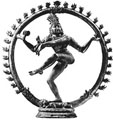| A Temporal View of Movement Discourse: Commentary |
Like any organism, a movement in its temporal extension has a lifespan. At the most basic, as Plato would have said, it has a beginning, middle, and end [See Griffin; Turner, "Social Dramas"]. The stages of a movement here are probable, not predetermined, and while they follow in this order logically, there is no particular timetable and stages may be omitted. There is also a cyclical possibility difficult to represent in linear form.
Rupture. In the basic pattern, movements arise from activated enclaves. What causes an enclave, or for that matter and individual, to become activated, move to alter the dimensions of the dominant public? To answer this we need to look at the epistemic gap between material conditions and discursive representation. Material reality is always larger, more complex and more in flux than any possible symbolic representation of it.
As a symbol system, language is not reality, it is a kind of verbal map of reality (Burke on terministic screens). As a system like any other, it has materiality because of its irreversibility, its existence in space and time. As a map like any other, its usefulness is due to the very fact that it is a reduction of reality, and never a complete reproduction. A map that included absolutely every detail of terrain would not be useful as a map (Jonathan Z. Smith).
Each exercise of language must, in addition to achieving its intended end, reconstruct its agents' own representation in language, along with the entire complex of assumptions and images that make up their social world (Giddens; Bakhtin, "Speech Genres,"). In its material aspect, language itself, like the rest of the universe, tends toward devolution, increasing variability and decreasing concordance in a process Bakhtin calls "heteroglossia" ("Discourse in the Novel"; cf. Burke on recalcitrance). All our linguistic interactions, therefore, must counteract heteroglossia in order to preserve the appearance of shared meaning. Every time we come back to language we find reality changed and we must stretch the language to realign it with reality.
Suppose there are times and places when the gap between material conditions and discursive representation is revealed as acute by a forced change of perspective (Burke, perspective by incongruity). When this gap is revealed, it is repaired by retrograde conversion, switching one's narrative memory systematically to the new perspective in a kind of cascade effect. Such a rupture can occur to an individual, for instance in a "conversion experience", or rarely to an entire group or culture as a result of massive and rapid change.
Formation. In its formative phase, a movement must invent its enthymemes and narratives, borrowing its premises from enclaves, other movements and the dominant public itself. This period is both creative and volatile, exhibiting less organizational structure and more spontaneous collective expression.
Constitution. As soon as a movement develops an identity and a set of core expressions that can be reproduced internally, it enters a constitutive phase where it must answer the necessity to reinforce movement identity, justify its own past actions, build traditions and maintain its own culture.
For as long as a movement lasts in its active phase, its voices and language will alternate between formative and constitutive moments as it adapts to events and changes in the dominant culture, including results of its own influence. At some point these materials or their audience may become exalted, or the exigence that drives the movement may be removed by its own success. At that point the movement reaches a stage of either
Suppression, Saturation or Schism. When a movement's languages, voices and strategies are exhausted its identity becomes unstable and it loses its reason for being. This saturation point can be caused by the success of a single strategy around which the movement had built its entire identity. Or a movement can reach a critical point and fail to complete a transformation of the dominant public, resulting in backlash and suppression. At a key point in the constitutive phase, when a measure of success and acceptance within the discourse of the dominant public has been achieved, any active movement will experience schism. This is because the fact of success requires a choice of strategy that affects movement identity, whether to accept mainstreaming as controversialists within the discourse of the dominant public, or to reject mainstreaming and retain radical identity but develop a separatist strategy..
Deformation. As a movement struggles through the alternatives and constraints of schism, saturation and suppression, its language enters a second phase of volatility and chaos. This is necessary part of the reproduction of the movement or the production of new movements. If the phase of deformation continues the movement will self-destruct and return to the status of an inert enclave. From this point, however, its language will survive in public memory and documents to become a resource should a moment of rupture and formation again arise.
 |
| Examples |